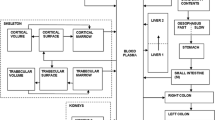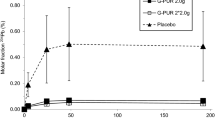Abstract
The bioavailability of chromium from Cr-picolinate (CrPic3) and Cr-chloride (CrCl3) was studied in rats using 51Cr-labelled compounds and whole-body-counting. The intestinal absorption of Cr was twice as high from CrPic3 (1.16% vs 0.55%) than from CrCl3, however most of the absorbed 51Cr from CrPic3 was excreted into the urine within 24 h. After i.v. or i.p. injection, the whole-body retention curves fitted well to a multiexponential function, demonstrating that plasma chromium is in equilibrium with three pools. For CrPic3, a large pool exists with a very rapid exchange (T 1/2 = <0.5 days), suggesting that CrPic3 is absorbed as intact molecule, from which the main part is directly excreted by the kidney before degradation of the chromium complex in the liver can occur. CrCl3 is less well absorbed but the rapid exchange pool is much smaller, resulting in even higher Cr concentrations in tissue such as muscle and fat. However, 1–3 days after application, the relative distribution of 51Cr from both compounds was similar in all tissues studied, indicating that both compounds contribute to the same storage pool. In summary, the bioavailability of CrPic3 in rats is not superior compared to CrCl3.



Similar content being viewed by others
References
Albarracin CA, Fuqua BC, Evans JL et al (2008) Chromium picolinate and biotin combination improves glucose metabolism in treated, uncontrolled overweight to obese patients with type 2 diabetes. Diabetes Metab Res Rev 24(1):41–51
Anderson RA (1998) Chromium, glucose intolerance and diabetes. J Am Coll Nutr 17:548–555
Anderson RA, Kozlovsky AS (1985) Chromium intake, absorption and excretion of subjects consuming self-selected diets. Amer J Clin Nutr 41:1177–1183
Anderson RA, Bryden NA, Polansky MM et al (1990) Urinary chromium excretion and insulinogenic properties of carbohydrates. Amer J Clin Nutr 51:864–868
Anderson RA, Bryden NA, Polansky MM et al (1996) Dietary chromium effects on tissue chromium concentrations and chromium absorption in rats. J Trace Elem Exp Med 9:11–25
Anderson RA, Bryden NA, Polansky MM (1997) Lack of toxicity of chromium chloride and chromium picolinate in rats. J Am Coll Nutr 16:273–279
Balk EM, Tatsioni A, Lichtenstein AH et al (2007) Effect of chromium supplementation on glucose metabolism and lipids: a systematic review of randomized controlled trials. Diabetes Care 30(8):2154–2163
Braunsfurth JS, Gabbe EE, Heinrich HC (1977) Performance parameters of the Hamburg 4 π whole body radioactivity detector. Phys Med Biol 22:1–17
Cefalu WT, Hu FB (2004) Role of chromium in human health and in diabetes. Diabetes Care 27:2741–2751
Cefalu WT, Bell-Farrow AD, Stegner J (1999) Effect of chromium picolinate on insulin sensitivity in vivo. J Trace Elem Exp Med 12:71–83
Clancy SP, Clarkson PM, DeCheke ME et al (1994) Effects of chromium picolinate supplementation on body composition, strength, and urinary chromium loss in football players. Int J Sport Nutr 4(2):142–153
Davis CM, Vincent JB (1997) Chromium oligopeptide activates insulin receptor tyrosine kinase activity. Biochemistry 36:4382–4385
DiSilvestro RA, Dy E (2007) Comparison of acute absorption of commercially available chromium supplements in humans. J Trace Elem Exp Med 21:274–275
Doisy RJ, Streeten DHP, Souma ML et al (1971) Metabolism of 51chromium in human subjects. In: Mertz W, Cornatzer WE (eds) Newer trace elements in nutrition. Dekker, New York, pp 155–168
Donaldson RM, Barreras RF (1966) Intestinal absorption of trace quantities of chromium. J Lab Clin Med 68:484–493
Dowling HJ, Offenbacher EG, Pi-Sunyer FX (1989) Absorption of inorganic, trivalent chromium from the vascularly perfused rat small intestine. J Nutr 119:1138–1145
Ducros V (1992) Chromium metabolism. A literature review. Biol Trace Elem Res 32:65–76
Evans GW, Pouchnick DJ (1993) Composition and biological activity of chromium-pyridine carboxylate complexes. J Inorg Biochem 49:177–187
Gammelgaard B, Jensen K, Steffansen BJ (1999) In vitro metabolism and permeation studies in rat jejunum: organic chromium compared to inorganic chromium. Trace Elem Med Biol 13(1–2):82–88
Gargas ML, Norton RL, Paustenbach DJ et al (1994) Urinary excretion of chromium by humans following ingestion of chromium picolinate. Implications for biomonitoring. Drug Metab Dispos 22:522–529
Hepburn DD, Vincent JB (2002) In vivo distribution of chromium picolinate in rats and implications for the safety of the dietary supplement. Chem Res Toxicol 15:93–100
Hopkins LL (1965) Distribution in the rat of physiological amounts of injected Cr51(III) with time. Am J Physiol 209:731–735
Hummel M, Standl E, Schnellet O (2007) Chromium in metabolic and cardiovascular disease. Horm Metab Res 39:743–751
Jain SK, Rains JL, Croad JL (2007) Effect of chromium niacinate and chromium picolinate supplementation on lipid peroxidation, TNF-α, IL-6, CRP, glycated hemoglobin, triglycerides, and cholesterol levels in blood of streptozotocin-treated diabetic rats. Free Radic Biol Med 43:1124–1131
Jeejeebhoy KN (1999) Chromium and parenteral nutrition. J Trace Elem Exper Med 12:85–89
Kareus SA, Kelley C, Walton HS et al (2001) Release of Cr(III) from Cr(III) picolinate upon metabolic activation. J Hazard Mater 84(2–3):163–174
Lim TH, Sargent T, Kusubov N (1983) Kinetics of trace element chromium(III) in the human body. Am J Physiol Regul Integr Comp Physiol 244:R445–R454
Lindemann MD, Carter SD, Chiba LI et al (2004) A regional evaluation of chromium tripicolinate supplementation of diets fed to reproducing sows. J Anim Sci 82:2972–2977
Martin J, Wang ZO, Zhang XH et al (2006) Chromium picolinate supplementation attenuates body weight gain and increases insulin sensitivity in subjects with type 2 diabetes. Diabetes Care 29:1826–1832
Mertz W (1993) Chromium in human nutrition: a review. J Nutr 123:626–633
Mertz W, Roginski EE, Reba RC (1965) Biological activity and fate of trace quantities of intravenous chromium(III) in the rat. Am J Physiol 209:489–494
Olin KL, Stearns DM, Armstrong WH et al (1994) Comparative retention/absorption of 51chromium (51Cr) from 51Cr chloride, 51Cr nicotinate and 51Cr picolinate in a rat model. Trace Elem Electrolytes 11:182–186
Onkelinx C (1977) Compartment analysis of metabolism of chromium(III) in rats of various ages. Am J Physiol 232(5):E478–E484
Sahina K, Ondercib M, Tuzcuc M et al (2007) Effect of chromium on carbohydrate and lipid metabolism in a rat model of type 2 diabetes mellitus: the fat-fed streptozotocin-treated rat. Metab Clin Exp 56:1233–1240
Sargent T, Lim TH, Jenson RL (1979) Reduced chromium retention in patients with hemochromatosis, a possible basis of hemochromatotic diabetes. Metabolism 28:70–79
Sreejayan N, Dong F, Kandadi MR, Yang X, Ren J (2008) Chromium alleviates glucose intolerance, insulin resistance, and hepatic ER stress in obese mice. Obesity 16:1331–1337
Striffler JS, Law JS, Polansky MM et al (1995) Chromium improves insulin response to glucose in rats. Metabolism 44:1314–1320
Trumbo PR, Ellwood KC (2006) Chromium picolinate intake and risk of type 2 diabetes: an evidence-based review by the United States Food and Drug Administration. Nutr Rev 64:357–363
Trumbo P, Yates AA, Schlicker S et al (2001) Dietary references intakes: vitamin A, vitamin K, arsenic, boron, chromium, copper, iodine, iron, manganese, molybdenum, nickel, silicon, vanadium, and zinc. J Am Diet Assoc 101:294–301
Vincent J (2000) The biochemistry of chromium. J Nutr 130:715–718
Vincent J (2001) The bioinorganic chemistry of chromium. Polyhedron 20:1–2
Acknowledgments
We thank Ulrich Quast for reading the manuscript. Parts of the data have been included in the medical thesis of Karin Kottwitz, at the University Hamburg, Germany.
Author information
Authors and Affiliations
Corresponding author
Rights and permissions
About this article
Cite this article
Kottwitz, K., Laschinsky, N., Fischer, R. et al. Absorption, excretion and retention of 51Cr from labelled Cr-(III)-picolinate in rats. Biometals 22, 289–295 (2009). https://doi.org/10.1007/s10534-008-9165-4
Received:
Accepted:
Published:
Issue Date:
DOI: https://doi.org/10.1007/s10534-008-9165-4




